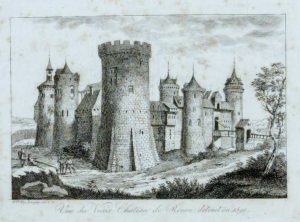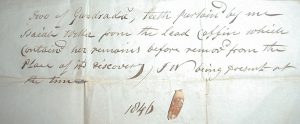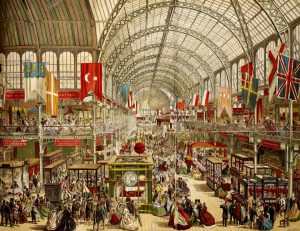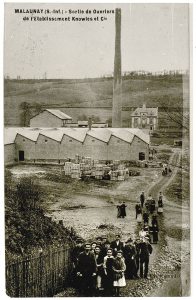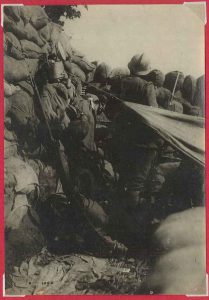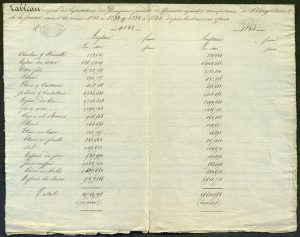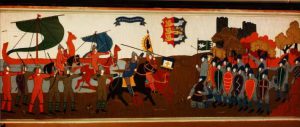Frise Chronologique
- 1000
- 1027
- 1066
- 1066
- 1085
- 1100
- 1115
- 1200
- 1204
- 1270
- 1300
- 1307
- 1410
- 1450
- 1562
- 1571
- 1572
- 1575
- 1575
- 1579
- 1579
- 1580
- 1636
- 1637
- 1639
- 1672
- 1735
- 1749
- 1757
- 1760
- 1771
- 1775
- 1786
- 1787
- 1787
- 1788
- 1792
- 1792
- 1800
- 1800
- 1801
- 1803
- 1806
- 1811
- 1816
- 1818
- 1818
- 1820
- 1821
- 1821
- 1821
- 1823
- 1830
- 1830
- 1836
- 1838
- 1840
- 1844
- 1844
- 1845
- 1851
- 1851
- 1855
- 1856
- 1857
- 1859
- 1862
- 1864
- 1871
- 1879
- 1881
- 1886
- 1889
- 1892
- 1894
- 1895
- 1898
- 1900
- 1900
- 1900
- 1900
- 1900
- 1900
- 1900
- 1900
- 1901
- 1906
- 1908
- 1908
- 1908
- 1910
- 1910
- 1914
- 1915
- 1915
- 1916
- 1917
- 1918
- 1920
- 1926
- 1932
- 1932
- 1939
- 1942
- 1942
- 1950
- 1955
- 1965
- 1966
- 4000
-
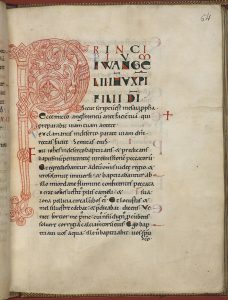 The Gospels of Jumièges
The Gospels of Jumièges11th century is deeply marked by the appearance of illumination in Norman manuscripts. This is mainly due to the monastic revival and the need for religious communities to build a library. England is so famous for its art schools and its signature style. Several workshops are experiencing significant radiation as those of Canterbury and Winchester.
Voir la fiche complète -
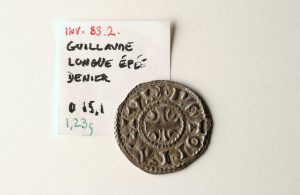 Silver coin to the effigy of Duke William Longsword
Silver coin to the effigy of Duke William LongswordThis coin show that Rollo’s dynasty had become established. It bears the likeness of Rollo’s immediate successor, William Longsword, his son from a first marriage (927-942)
Voir la fiche complète -
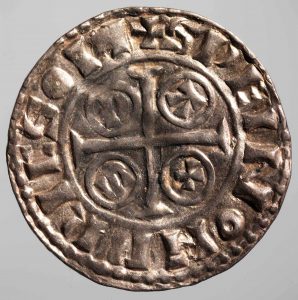 Silver pennies from William the Conqueror
Silver pennies from William the ConquerorThese silver pennies, minted in England after his victorious battle, show the face of William the Conqueror. The first, minted in London, dates from 1066-1068 The others, from 1072-1074 and 1083-1086, were minted in Exeter, Bristol and Wilton.
Voir la fiche complète -
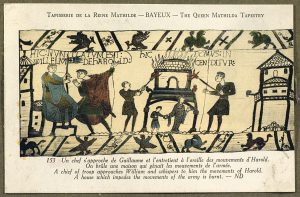 Bayeux Tapestry
Bayeux TapestryBayeux Tapestry, or Queen Matilda's Tapestry, or even older Tale of the Conquest is a 70 meter-long embroidery, composed of 9 panels of linen cloth, showing 58 scenes, each being captioned in Latin.
Voir la fiche complète -
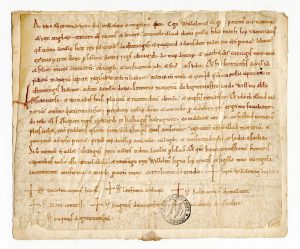 Confirmation charter of William the Conqueror to Fécamp Abbey of Steyning
Confirmation charter of William the Conqueror to Fécamp Abbey of SteyningConfirmation charter of William the Conqueror (patronus of the Normans and King of the English) to Fécamp Abbey of Steyning (Estaninges), West Sussex, which King Edward (the Confessor) made to the abbey. He also grants the manor of Bury to the abbey in compensation for the claim which they made against him for the property which they had in Hastings (Hastinges) in king Edward’s time.
Voir la fiche complète -
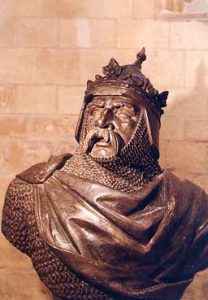 William the Conqueror
William the ConquerorDespite the difficult start where the young Duke has to face opposition from a part of the Norman aristocracy, peace is essential in the duchy and the ducal power is reinforced. William grows his ancestors' past alliances and develops new ones, imposing himself as a territorial prince with international reputation.
Voir la fiche complète -
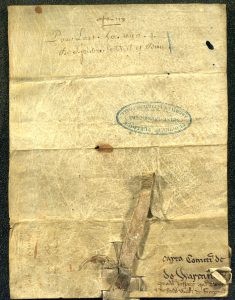 Charter of William of Warenne, son of the first Lord of Lewes
Charter of William of Warenne, son of the first Lord of LewesAfter the Conquest, Sussex was divided into administrative areas known as " rapes ". There were three in East Sussex - Hastings, Pevensey and Lewes. Count of Eu received the rape of Hastings, Count of Mortain that of Pevensey, while Guillaume de Varenne became Lord of Lewes.
Voir la fiche complète -
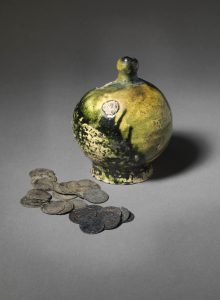 Piggy bank and coins
Piggy bank and coinsIn late 12th century and early 13th century, in the French regions dominated by the Kings of England from the dynasty of Plantagenêt, english coins circulated frequently along with local coins.
Voir la fiche complète -
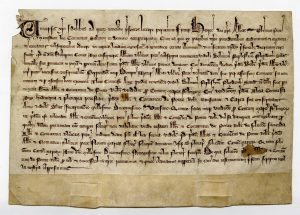 Certificate for payment by Henry abbot of Tréport to the abbot and convent of Robertsbridge
Certificate for payment by Henry abbot of Tréport to the abbot and convent of RobertsbridgeHenry abbot of Tréport (in Normandy) reminds that tenements at Bolinton and Pebsham (in Bexhill), Playden and Stand was sold to the abbot and convent of Robertsbridge, for £66 13s 4d.
Voir la fiche complète -
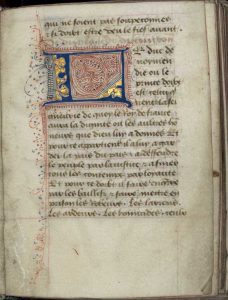 Norman customs
Norman customsNormandy had laid down in writing a set of legal rules, called the Très ancien coutumier de Normandie in the late part of the 12th century. The second part of these rules would be put in writing after Normandy became part of France in the first half of the 13th century and was to remain in force until the Revolution.
Voir la fiche complète -
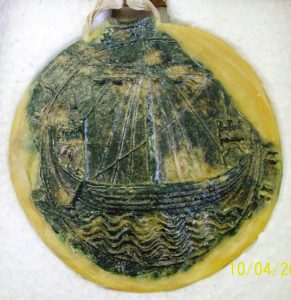 Seal of Rye
Seal of RyeA deed conveying property in Merstret in Rye from John and Alice Torel to Peter and Denise Hegsthone. There are two seals attached, both in green wax. The smaller is of John Torel and shows a ship with one mast.
Voir la fiche complète -
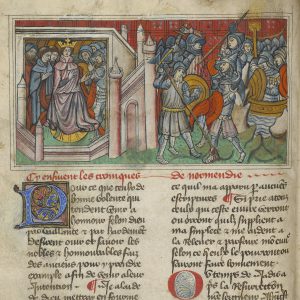 Chronicles of Normandy
Chronicles of NormandyThe text was written between 1350 and 1370 by an anonymous Norman author, probably from Rouen. This story is based on the Roman de Rou of Wace (1160-1174), as well as on the Chronicle of Normandy of the 13th century. The Chronicle focuses on Norman ducal and royal English characters. It begins in 911 with Rollo, the Viking chief, whom the king of France Charles III the Simple donated the County Rouen in the Treaty of Saint -Clair sur Epte. Depending on the version, the story ends either in 1204, with the annexation of Normandy to the crown of France, or at the latest in 1217 with the accession to the English crown of Henry III , son of John Lackland.
Voir la fiche complète -
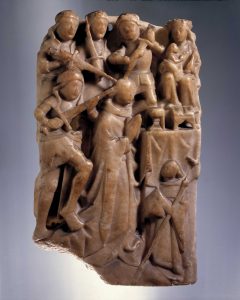 English alabaster carving depicting the murder of Saint Thomas Becket
English alabaster carving depicting the murder of Saint Thomas BecketEnglish alabaster carving depicting the murder of Saint Thomas Becket, second half of the 15th century. Semi-relief. Musée des Antiquités, inv. 626.
Voir la fiche complète -
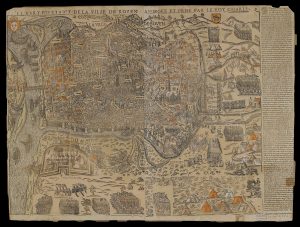 Map of Rouen besieged and taken by Charles IX
Map of Rouen besieged and taken by Charles IXLarge Protestant communities became established in Upper Normandy, centred mainly on Rouen and Dieppe, following the Protestant Reformation. The Huguenots took control of Rouen in April 1562 shortly after the massacre of Vassy, which marked the start of the civil war, and indulged in large-scale destruction, including mutilation of the statues in the cathedral.
Voir la fiche complète -
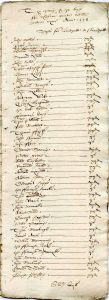 List of French Protestant refugees in Rye
List of French Protestant refugees in RyeOrder from the Lords of the Council, 28 October 1571, ordered a survey to be made of strangers (foreigners) in the town and for undesirables to be expelled
Voir la fiche complète -
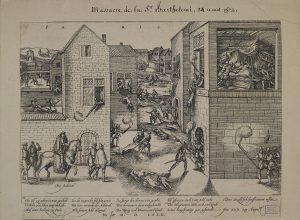 Massacre of Saint-Bartholomew, 24 August 1572
Massacre of Saint-Bartholomew, 24 August 1572Tragic episode of the religious wars, the massacre of Protestants triggered in Paris on August 24, 1572, on St. Bartholomew’s day, continued for several days in the capital, and then extended to more than a dozen province cities during the following weeks.
Voir la fiche complète -
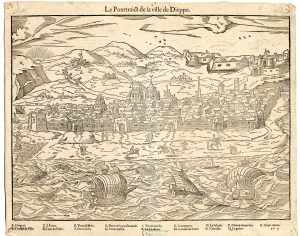 Portrait of Dieppe
Portrait of Dieppe"Le Pourtraict de la ville de Dieppe", by François de Belleforest (1530-1583), 1575. Wood engraving.
Voir la fiche complète -
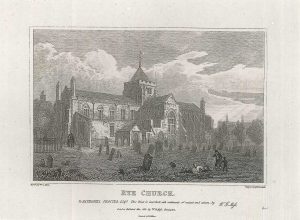 Parish register of Rye showing baptisms and marriages of members of the French church
Parish register of Rye showing baptisms and marriages of members of the French churchA large French colony fled to Rye, a coastal town in East Sussex and the main landing point at that time for ships leaving Dieppe, to escape persecution.
Voir la fiche complète -
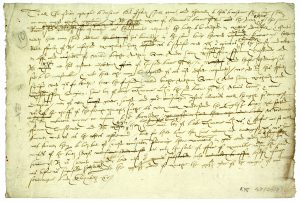 Certificate by the Mayor and Jurats of Rye
Certificate by the Mayor and Jurats of RyeCertificate by the Mayor and Jurats of Rye, 27 March 1579, as to the good character of a number of French settlers in the town, including Anthony Cocke.
Voir la fiche complète -
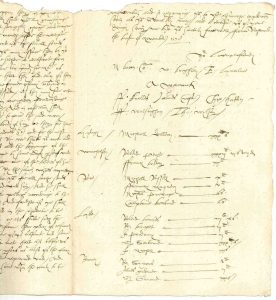 Draft letter from The Mayor and Jurats of Rye to Richard Barry, Lieutenant of Dover Castle, concerning fines for piracy
Draft letter from The Mayor and Jurats of Rye to Richard Barry, Lieutenant of Dover Castle, concerning fines for piracyThe letter lists men suspected of piracy at Hastings, Rye, Lydd and Romney, a number of whom are French. They include Frances Maquery from Rye, a French merchant from Dieppe, who also appears elsewhere in the exhibition.
Voir la fiche complète -
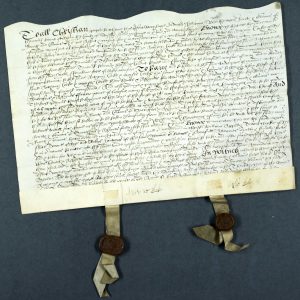 Counterpart bargain and sale to Frenchman
Counterpart bargain and sale to FrenchmanCounterpart bargain and sale to Frenchman Anthony Cocke and Moses his son of vacant ground, 43 × 14 ft., outside the Strandgate of Rye under the town wall, between Thomas Radforde's tenement and the new conduit for a rent of 4d a year. There are two seals, on tags, (1) a cock upon a letter N, with legend LE COQ; and (2) an anchor.
Voir la fiche complète -
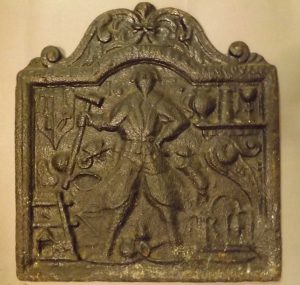 Fireback
FirebackFireback showing Richard Lennard, the founder at Brede Furnace, with the tools and products of his trade. His initials appear in a cartouche in the bottom right hand corner. A furnace is shown at bottom, and a wheelbarrow is tipping materials into the top of the furnace.
Voir la fiche complète -
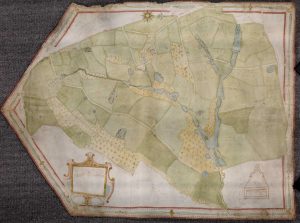 Map of Robert Wildgoose's capital messuage called Iridge in Salehurst by Ambrose Cogger
Map of Robert Wildgoose's capital messuage called Iridge in Salehurst by Ambrose CoggerThis map clearly shows the complex system of artificial ponds created to service the Iridge furnace.
Voir la fiche complète -
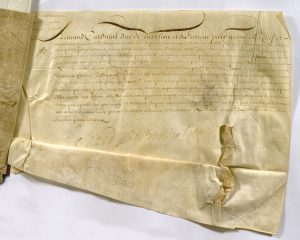 Cardinal Richelieu's instructions to Captain Daniel
Cardinal Richelieu's instructions to Captain DanielThe end of the Hundred Years War placed Normandy away from foreign wars for several centuries. This does not preclude the province to participate in transactions, including shipping. Captain Charles Daniel, a native from Dieppe, who served many commandments in the Royal Navy, is a fine example of a naval officer.
Voir la fiche complète -
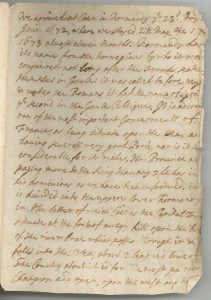 Part of diary probably kept by John Ashburnham
Part of diary probably kept by John AshburnhamJohn, afterwards 1st Baron Ashburnham, aged 17 on a 'Grand Tour' through France and Switzerland.
Voir la fiche complète -
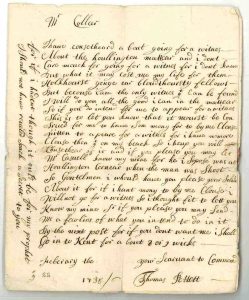 Letter from Thomas Pettet to John Collier
Letter from Thomas Pettet to John CollierCollier (1685-1760) was Solicitor for the Crown assisting in trials of smugglers until 1733 when he was appointed Surveyor-General of the Riding Officers of Kent.
Voir la fiche complète -
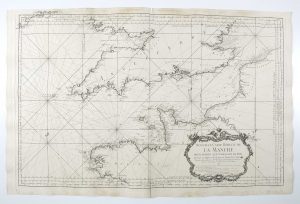 New smaller map of the Channel to assist the King’s ships
New smaller map of the Channel to assist the King’s shipsThe Channel is one of the busiest seas in the world from the point of view of ship numbers, and covers an area of 75,000 km2.
Voir la fiche complète -
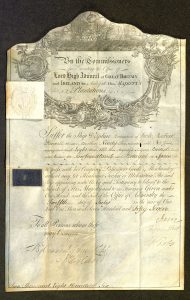 Appointment of an English captain
Appointment of an English captainDated 1757, this document appoints Robert Farwell as captain of the Dolphin, an unarmed trading ship with a capacity of 90 tons and bound for Newfoundland, Portugal or Spain. The appointment was made in the name of the Lord High Admiral “of Great Britain and Ireland etc. and of all His Majesty’s plantations”.
Voir la fiche complète -
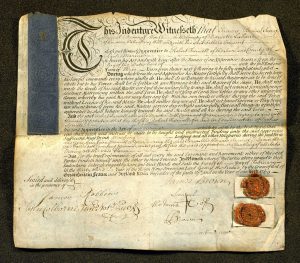 Apprenticeship contract
Apprenticeship contractThis document is a sailor’s apprenticeship contract (1760). It is in the format of a mediaeval chirograph: these documents were drawn up in duplicate, one over the other, and cut through along a zig-zag line or indent so that the two parts could be matched together (this is why these contracts are also called indentures).
Voir la fiche complète -
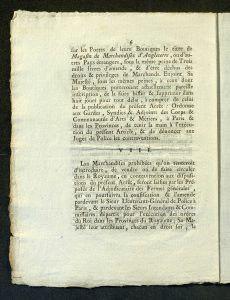 report drawn up by John Holker junior containing suggestions as to how to combat English smuggling
report drawn up by John Holker junior containing suggestions as to how to combat English smugglingIn this report, John Holker junior describes the goods smuggled and lists the French and foreign ports where they are landed, and accuses some Dieppe fishermen of being involved.
Voir la fiche complète -
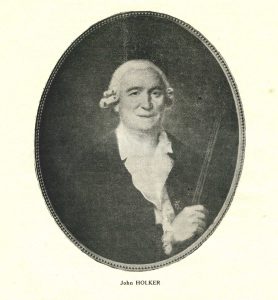 John Holker’s coat of arms and his letters of ennoblement, registered by the Cour des Aides
John Holker’s coat of arms and his letters of ennoblement, registered by the Cour des AidesBorn in Stretford in England and a supporter of the Stuart claimant to the throne, John Holker had to leave his native land for political reasons. When he arrived in the capital of Normandy he joined forces with an industrialist of Darnétal to set up a manufactory.
Voir la fiche complète -
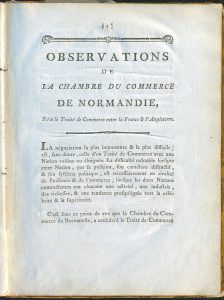 Observations of the Normandy Chamber of Commerce on the trade treaty between France and England
Observations of the Normandy Chamber of Commerce on the trade treaty between France and EnglandIn this memorandum the Chamber of Commerce records its views on the navigation and trade treaty of 1786, having sent two representatives to England. It notes that, contrary to the situation in France, English corporations of merchants and manufacturers had been consulted and had managed to have some clauses that might be detrimental to their business deleted.
Voir la fiche complète -
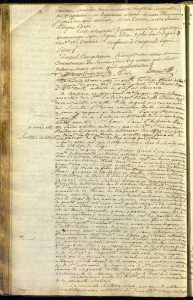 King's letter to Captain Smith
King's letter to Captain SmithKing's letter authorizing Captain Smith, English ship commander, to order under the French flag a vessel plying the slave trade, without receiving act of reception, recorded on March 17, 1787.
Voir la fiche complète -
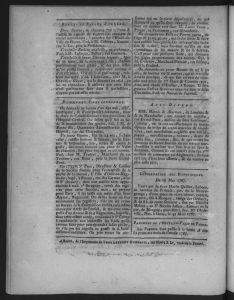 Opening of an English store in Rouen
Opening of an English store in RouenAdvertisement for the opening of a store in Rouen, rue Grand Pont, by two Englishmen, July 7 1787.
Voir la fiche complète -
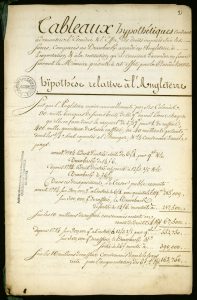 Letter and report about English and French trade after Treaty of Eden-Rayneval, 1786.
Letter and report about English and French trade after Treaty of Eden-Rayneval, 1786.Letter to the members of the Chamber of Commerce of Le Havre and a comparative report of the English and French trade after the Treaty of Commerce 1786, 1788
Voir la fiche complète -
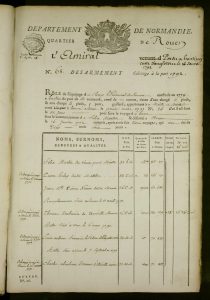 Wreck log of the Amiral, lost off Hastings
Wreck log of the Amiral, lost off HastingsCommercial shipping registers show the extent of sea trade on ships leaving Upper Normandy.Some ships were shipwrecked before they reached their destination, as was the case of the Amiral which was lost off the English coast near Hastings on 16 January 1792.
Voir la fiche complète -
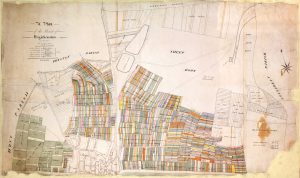 Map of Brighton
Map of BrightonView 1 : Plan of the Parish of Brighthemstone, 1792 130 x 82 (ESRO: AMS 4106) View 2 : Map of the town of Brighton and its environs, 1850 by Ligott Smith for the regent King George IV 144 x 113 (ESRO : QDP 133)
Voir la fiche complète -
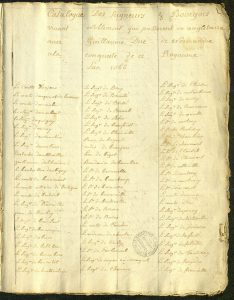 List of the companions of William the Conqueror
List of the companions of William the ConquerorUpon Edward the Confessor's death in 1066, Harold is crowned King of England, and takes the throne which amounted to William the Conqueror. When Harold refuses to give the kingdom back to him, William decides to raise an army and get across the Channel.
Voir la fiche complète -
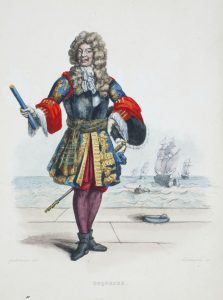 Abraham Duquesne
Abraham DuquesneLithograph dated 19th century. Born in 1610 in Dieppe from a Huguenot family, Abraham Duquesne takes his first command in the Navy at 18 years.
Voir la fiche complète -
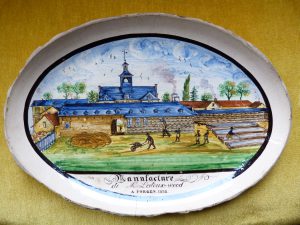 Plates made during the second period of operations of the Ledoux-Wood workshops, undated. Drawing in pen, pencil and wash by C. Ridey
Plates made during the second period of operations of the Ledoux-Wood workshops, undated. Drawing in pen, pencil and wash by C. RideyIt was in 1797 that the Englishman George Wood set up his business in Forges-les-Eaux. He concentrated on the production of “fine earthenware”, made according to a technique developed in England in the 18th century, designed to look like porcelain.
Voir la fiche complète -
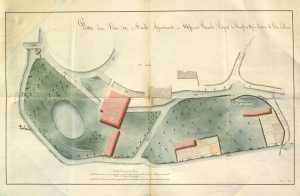 Plan of a factory in Déville owned by Messrs. Rawle, Poupard de Neuflize and son, Sevesne and John Colliere
Plan of a factory in Déville owned by Messrs. Rawle, Poupard de Neuflize and son, Sevesne and John ColliereValentin Rawle was the first person to set up water-driven spinning Jennies in the Rouen area. They were visited by Napoleon himself. Rawle had opened his first cotton mill, holding 6,000 spindles on two floors, in 1798.
Voir la fiche complète -
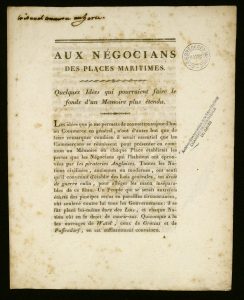 Report addressed to seaports traders mentioning the abuses of English pirates
Report addressed to seaports traders mentioning the abuses of English piratesThis report aims at encouraging traders from Le Havre to meet and assess their lost incomes from English piracy in the colonies. This document highlights one of the origins of the Franco-British conflict in18th and 19th centuries. Indeed, trade with the colonies is an economic issue.
Voir la fiche complète -
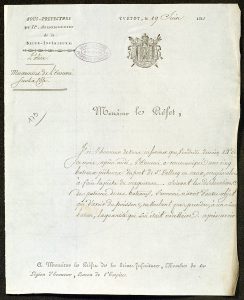 Enemy movement on the Norman coast
Enemy movement on the Norman coastLetter from the Deputy Prefect to the Prefect dated June 19, 1811 ; title: " enemy movement on the coast "
Voir la fiche complète -
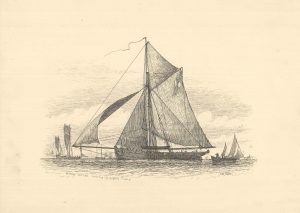 Revenue Cutter
Revenue CutterA Revenue cutter is a small lighty armed boat, used to enforce customs regulations and catch smugglers.
Voir la fiche complète -
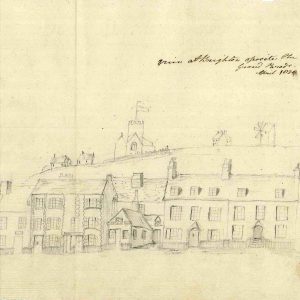 Illustrated diary of Frances Sayer's visit to Brighton in 1818
Illustrated diary of Frances Sayer's visit to Brighton in 1818Frances Sayer was visiting at a time when Brighton was growing as a bathing resort frequented by the Prince Regent, whose summer palace, the Pavilion, was still under construction.
Voir la fiche complète -
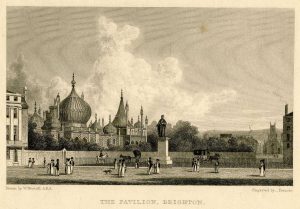 Royal Pavilion at Brighton
Royal Pavilion at BrightonBrighton is a town and one of the most famous seaside resorts in England. It was brought into fashion, notably by Albert Abdullah David Sassoon, the “Indian Rothschild” in the 1870s. Among its famous buildings, the extravagant Royal Pavilion raised as a residence for the Prince Regent, later King George IV.
Voir la fiche complète -
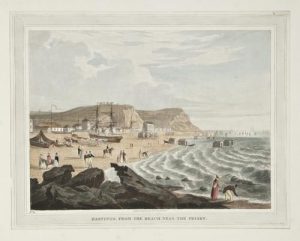 Plan of a bathing machine
Plan of a bathing machinePlan of a cheap and simple rolling bathing machine consisting of a light framework covered with canvas “as used on the coast of France” from the archives of the Brighton Improvement Commissioners, c 1820s.
Voir la fiche complète -
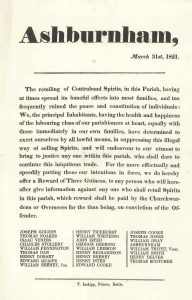 Printed notice about contraband spirits
Printed notice about contraband spiritsPrinted notice offering reward for information about retailing contraband spirits, which would have included French brandy.
Voir la fiche complète -
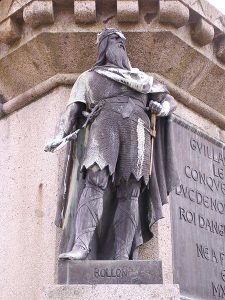 Lithography of Rollo, first duke of Normandy
Lithography of Rollo, first duke of NormandyFirst Earl of Normandy, Rollo has generated much controversy. From Denmark or Norway, his story is known to us through Dudo of Saint -Quentin, Norman chronicler of 11th century.
Voir la fiche complète -
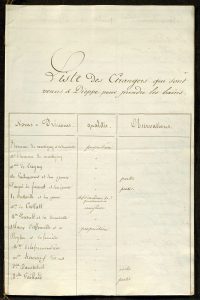 List of foreigners travelling to Dieppe for sea-bathing
List of foreigners travelling to Dieppe for sea-bathingSea-bathing became fashionable in Normandy in the 19th century, following the trend set in England by Brighton.
Voir la fiche complète -
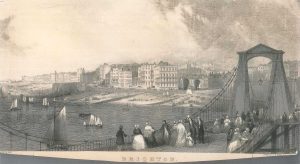 Brighton Chain Pier
Brighton Chain PierThe Brighton Chain Pier was opened on 25 November 1823. The pier was primarily intended as a landing stage for packet boats to Dieppe, until they transferred to the more sheltered Newhaven. It was different from typical piers because, rather than being built on stilts, the deck of the pier was suspended from chains attached to pillars
Voir la fiche complète -
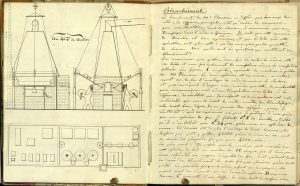 Journal of notes made in England by Camille Koechlin on the premises of Messrs. Thomson, Chippindall & Co. near Manchester
Journal of notes made in England by Camille Koechlin on the premises of Messrs. Thomson, Chippindall & Co. near ManchesterCamille Koechlin, a member of a textile-manufacturing family from Alsace, used this journal to record his observations on a trip to England during which he visited the premises of Thomson, Chippindall & Co. near Manchester.
Voir la fiche complète -
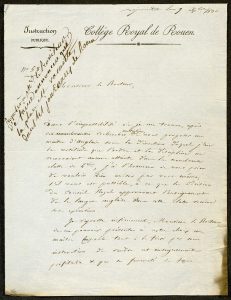 Seeking an English teacher: Letter from the Collège royal de Rouen to the rector of the Academy
Seeking an English teacher: Letter from the Collège royal de Rouen to the rector of the AcademyShortly after the Royal Council for Public Education had given its approval to the teaching of English, the Collège royal de Rouen, the forerunner to the Lycée Corneille, wrote to the rector complaining of difficulty in finding a qualified teacher.
Voir la fiche complète -
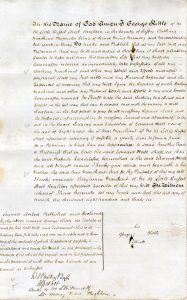 Will of George Kittle, bathing machine proprietor
Will of George Kittle, bathing machine proprietorHe leaves his bathing machines in trust to keep them in repair and to pay for the board, lodging and education of Edward Hall, the son of Ann Marchant, who is living at the same Brighton address as Kittle.
Voir la fiche complète -
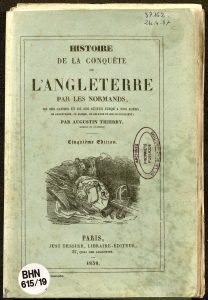 History of the Norman Conquest of England
History of the Norman Conquest of England"Histoire de la conquête de l'Angleterre par les Normands : de ses causes et de ses suites jusqu'à nos jours, en Angleterre, en Ecosse, en Irlande et sur le continent" by Augustin Thierry. Fifth edition. Paris, Just Tessier, 1838.
Voir la fiche complète -
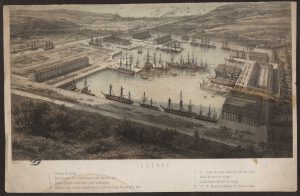 Extension project for the port of Dieppe, with the creation of a port of refuge. Colour lithography by Rivière
Extension project for the port of Dieppe, with the creation of a port of refuge. Colour lithography by RivièreThis perspective view of Dieppe, designed around 1840, highlights two ambitious infrastructure projects that never emerged: on the foreground, a large basin meant for receiving tall ships, extends to Neuville; to reach it, the ships used a channel “going to Paris”.
Voir la fiche complète -
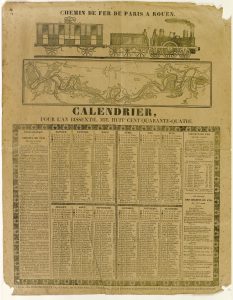 Calendar of Paris - Rouen railway
Calendar of Paris - Rouen railwayThis 1844 calendar depicting a railway commemorates the start of train travel in the Lower Seine. The line, almost 130 kilometres long, follows the Seine valley. Work started in May 1840 and was in English hands.
Voir la fiche complète -
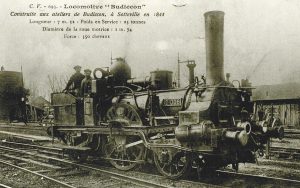 Budiccom locomotive
Budiccom locomotiveThe Compagnie de Rouen had to be able to produce carriages and locomotives in order to be able to run the line. The backers of the proposed railway line between Paris and Rouen again turned to England, which already supplied many of the locomotives used in France.
Voir la fiche complète -
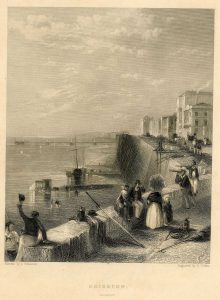 Sketch book of Sussex views
Sketch book of Sussex viewsView of the Brighton chain pier. Nothing is known of the artist or the provenance of the sketch book.
Voir la fiche complète -
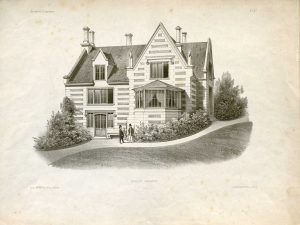 English house. Plate taken from “Habitations champêtres” by A. Petit
English house. Plate taken from “Habitations champêtres” by A. PetitBooks containing architectural plates became increasingly popular in the second half of the 19th century.
Voir la fiche complète -
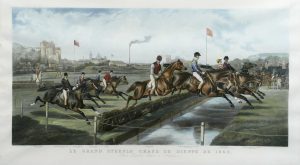 The grand Dieppe steeplechase by Louis Heyrault, lithography
The grand Dieppe steeplechase by Louis Heyrault, lithographyDieppe followed the English fashion for horse-racing, opening a racecourse as early as 1852 at which steeplechases were held. Followers of horse-racing were known as “sportsmen”, while the word “sport” was used in France only to describe horse-racing, as in the definition given in the 1883 edition of the Littré dictionary.
Voir la fiche complète -
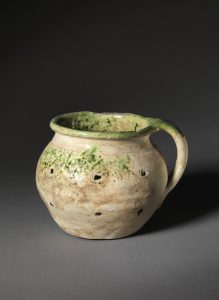 Absolution cross and funeral pot
Absolution cross and funeral potIn the Middle Ages, these crosses were placed on the dead, both in France and England, along with a funeral pot. They have the shape of the Maltese cross and remember quite well the consecration crosses and crosses of cemeteries in 12th century.
Voir la fiche complète -
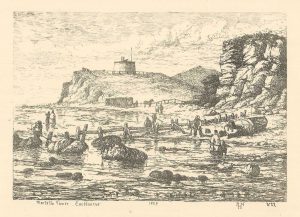 View of Eastbourne, by Henry Nibbs
View of Eastbourne, by Henry NibbsA view of Eastbourne showing bathing machines on the beach.
Voir la fiche complète -
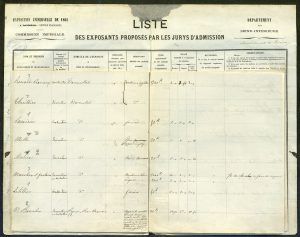 World exhibition in London, 1862
World exhibition in London, 1862List of participants from Rouen suggested by the admission jury
Voir la fiche complète -
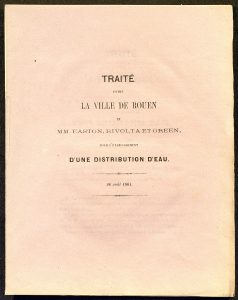 Treaty between Rouen and MM. Easton, Rivolta and Green for the establishment of a water supply, 26 August 1864
Treaty between Rouen and MM. Easton, Rivolta and Green for the establishment of a water supply, 26 August 1864After several studies about the project of drinking water distribution in Rouen, the town assigns in this treaty the concession of water supply to M. Easton, Rivolta and Green in 1864. The object of the concession covers the distribution and sale of water for public and private needs.
Voir la fiche complète -
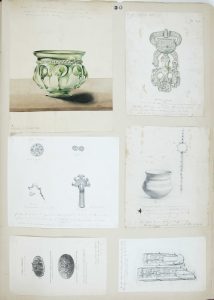 Scandinavian fibulae
Scandinavian fibulaeObjects on this board were all presented to the departmental Commission of Antiquities on 23 May 1871. Preserved in the Museum of Antiquities, they were discovered in several places in Seine -Maritime and Eure between 1840 and 1871 ( Aubermesnil-les-Erables, Caudebec, Pîtres ) .
Voir la fiche complète -
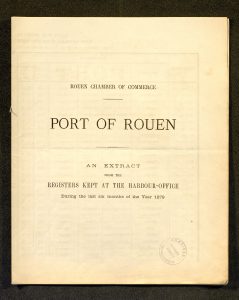 Movements of vessels in the port of Rouen
Movements of vessels in the port of RouenReport of the Chamber of Commerce, in English. It was not until the mid-nineteenth century that the practice of free trade between the two sides of the Channel really develops.
Voir la fiche complète -
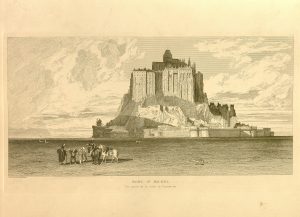 Architectural Antiquities of Normandy by John Sell Cotman - London, J. & A. Cornhill
Architectural Antiquities of Normandy by John Sell Cotman - London, J. & A. CornhillMany British citizens started to explore their Anglo-Norman roots from the second half of the 18th century onwards. Normandy was a popular destination for artists: painters like Turner, photographers like Tenison, but also engravers who reproduced their creations.
Voir la fiche complète -
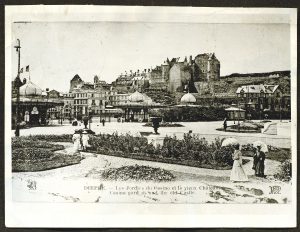 Casino, Old Castle and baths at Dieppe
Casino, Old Castle and baths at DieppeThe first bathing establishment was founded in 1822 by the Earl of Brancas , sub-prefect of the town. This property, surrounded by a garden with its elegant colonnade, is considered the first casino in Dieppe. Marie-Caroline, Duchess of Berry, daughter of King Charles X , attracts people of the court and many artists, such as Rossini, in Dieppe.
Voir la fiche complète -
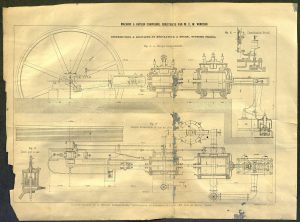 Compound steam engine built by M. E. Windsor (English designer/engineer based in Rouen), plate taken from the “Revue industrielle” produced during the 1889 World Fair
Compound steam engine built by M. E. Windsor (English designer/engineer based in Rouen), plate taken from the “Revue industrielle” produced during the 1889 World Fairhe plate shows a two-cylinder steam engine built by E. W. Windsor. The construction of these machines made the name of the company, and of Rouen engineering.
Voir la fiche complète -
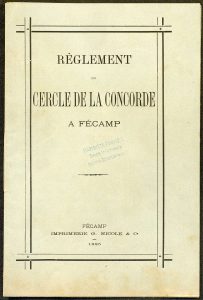 The fashion for English clubs: list of members of the Grand cercle du casino de Dieppe
The fashion for English clubs: list of members of the Grand cercle du casino de DieppeClubs became increasingly popular in Normandy, especially on the coast, in response to the English influence. The Cercle de la Concorde in Fécamp described its objective as offering residents somewhere “to talk about business and enjoy each other’s company”.
Voir la fiche complète -
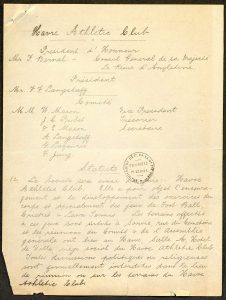 The first football club in France: bye-laws of the Le Havre Athletic Club
The first football club in France: bye-laws of the Le Havre Athletic ClubThe Le Havre Football club was set up in 1872 by English Protestant expatriates working as traders or shop assistants in Le Havre. In 1891 the Le Havre Athletic Club adopted the colours of the English universities where the players had studied: the famous light blue of Cambridge and dark blue of Oxford.
Voir la fiche complète -
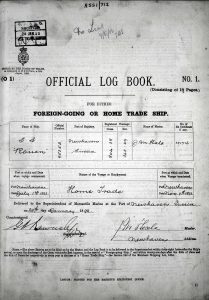 Official log book for the SS Rouen of Newhaven
Official log book for the SS Rouen of NewhavenThis book is not the ship’s log proper but a record of certain categories of incident (eg deaths, disturbances on board) which were statutorily required to be reported to the Registrar General of Shipping and Seamen. It includes a list of crew members with a report on their character and ability in seamanship.
Voir la fiche complète -
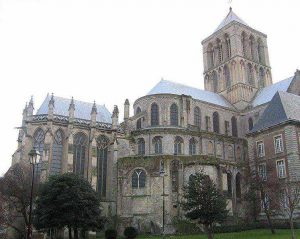 Fécamp Abbey, watercolour by Paul Marny
Fécamp Abbey, watercolour by Paul MarnyFécamp had an important role as early as the reign of William Longsword (927-942), the son of Rollo, thanks to the existence of a ducal residence near the former abbey which had been abandoned at the end of the ninth century before being restored as a collegiate church by Richard I in 990 and then being given abbey status in 1001 by Richard II.
Voir la fiche complète -
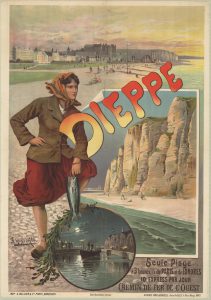 Dieppe, posters issued by the Western Railways
Dieppe, posters issued by the Western RailwaysShortly before 1900, new printing processes gave rise to large advertising poster format. This support, among others, allows railway companies to promote tourist sites served by rail.
Voir la fiche complète -
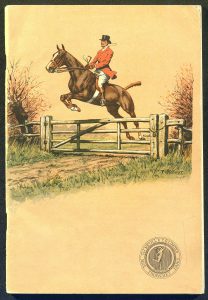 So british ! : "L’Art de bien s’habiller”; "Album des costumes"
So british ! : "L’Art de bien s’habiller”; "Album des costumes"Even in clothes made from a particular type of high-quality fabric made in the Normandy town of Elbeuf, “the art of dressing well” was regarded as synonymous with the art of wearing English-style clothes, whether for sports (golf, tennis and horse-racing), in town or on formal occasions.
Voir la fiche complète -
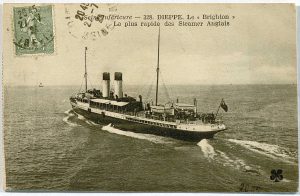 Dieppe, the Brighton, the fastest of the English steamers, postcard
Dieppe, the Brighton, the fastest of the English steamers, postcardThe Brighton, the fourth vessel to bear this name was one of the first turbine-driven liners on the Dieppe-Newhaven route. Built at the Dumbarton shipyard in Scotland, it had two propellers and ran at 6,000 horsepower.
Voir la fiche complète -
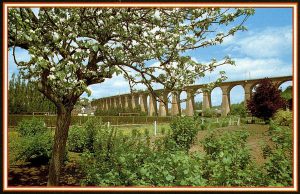 The “Nouveau Pont aux Anglais”; Malaunay, the arches of the viaduct
The “Nouveau Pont aux Anglais”; Malaunay, the arches of the viaductFive long tunnels had to be dug and six viaducts constructed over the Seine in the building of the Paris to Rouen railway.
Voir la fiche complète -
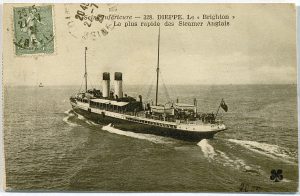 Dieppe, The Newhaven steamer entering port
Dieppe, The Newhaven steamer entering portThe « Newhaven » is a French turbine-and-propeller-driven liner. Built at the Forges et Chantiers de la Méditerranée in Le Havre, taken intoservice in 1911 and modified to run on oil in 1932, it was 92 metres long with a top speed of 24 knots.
Voir la fiche complète -
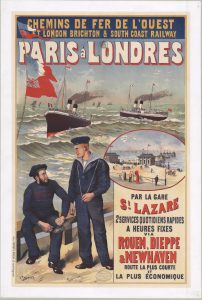 Chemins de fer de l’Ouest et London Brighton and South Coast Railway Illustrated colour poster
Chemins de fer de l’Ouest et London Brighton and South Coast Railway Illustrated colour posterThe earliest tourism posters were produced for the Compagnie des Chemins de fer del’Ouest in 1886, with towns and tourist offices following this example later on.
Voir la fiche complète -
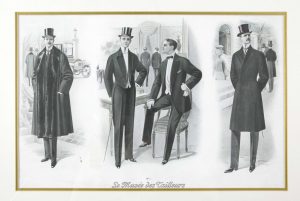 English evening dress: fashion plate from the fashion magazine “Le Musée des Tailleurs”
English evening dress: fashion plate from the fashion magazine “Le Musée des Tailleurs”French male fashion was strongly influenced by England, especially from the nineteenth century onwards.
Voir la fiche complète -
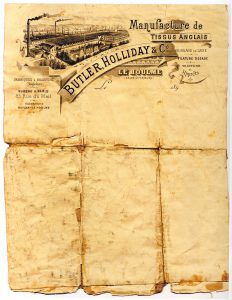 Butler-Holliday & Co : Company incorporation's deed
Butler-Holliday & Co : Company incorporation's deedThe Butler and Holliday families were well-known English industrialists: the Butlers produced textiles in Bingley while the Hollidays made chemicals in Huddersfield.
Voir la fiche complète -
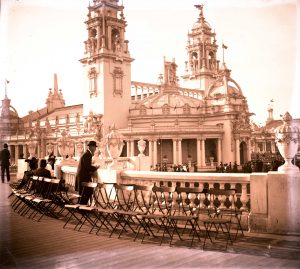 The Franco-British Exhibition of 1908
The Franco-British Exhibition of 1908The Franco-British Exhibition of 1908 : side-view of the pavilion's entrance. Glass negatives by Louis Chesneau, August 1908.
Voir la fiche complète -
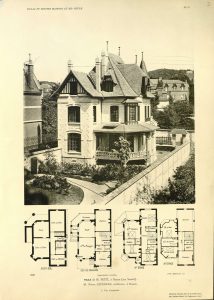 Rouen, villa in the rue Senard, architect P. Lefebvre. Printed plate taken from “Villas et petites maisons du XXe siècle”, Paris - Central Art and Architecture Library
Rouen, villa in the rue Senard, architect P. Lefebvre. Printed plate taken from “Villas et petites maisons du XXe siècle”, Paris - Central Art and Architecture LibraryThis middle-class home shows how influential the regionalist trend was both in towns and at the seaside.
Voir la fiche complète -
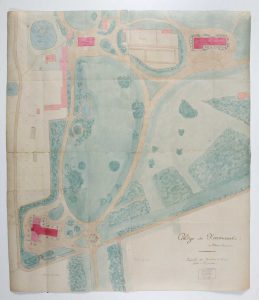 A public school in Mont-Cauvaire: plan of the pupils houses
A public school in Mont-Cauvaire: plan of the pupils housesThe Collège de Normandie opened its doors in 1902. It was a private school for Catholic and Protestant pupils from the ages of 7 to 9 right through to the school-leaving examination. It was modelled on Harrow school in England. Modern languages were a prominent feature of the syllabus, and all pupils had to spend three months at a school in England.
Voir la fiche complète -
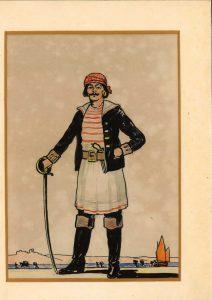 Drawing of a smuggler
Drawing of a smugglerRomanticised drawing of a smuggler, with the outline of the shore with Hastings Castle, and a run in progress from a lugger, by E. Leslie Badham (1873-1945), pen and ink.
Voir la fiche complète -
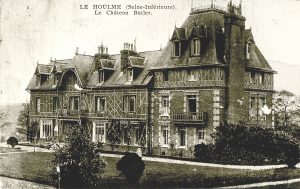 Butler's castle and city, Le Houlme
Butler's castle and city, Le HoulmeInstalled at Le Houlme since 1883 on the site of an old mill, Henry and Alfred Butler associated with leaving Charles and Thomas Holliday extend the site with the construction of new workshops, a working class city and two employers' homes
Voir la fiche complète -
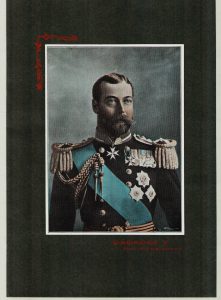 Telegram announcing the visit of King George V
Telegram announcing the visit of King George VThe telegraph, along with carrier pigeons and radio, was a fast and effective means of communication between the Allies and the front line during the war. Messages were always sent in code to prevent the enemy intercepting the information. This message, encrypted using a highly sophisticated cipher, relates to the secret visit made by King George V to British troops in Rouen.
Voir la fiche complète -
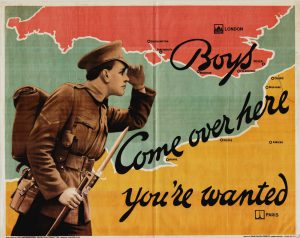 First World War posters
First World War postersPosters published in large numbers by the Parliamentary Recruiting Committee, probably in 1915, were aimed at the young Englishmen who might be considering joining up for active servuice at the front.
Voir la fiche complète -
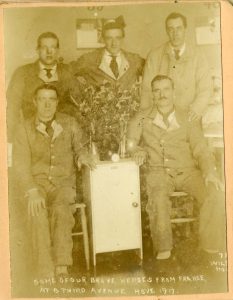 Autograph book of a nurse serving soldiers
Autograph book of a nurse serving soldiersMy dug-out: an entry in the autograph book of a hospital nurse serving convalescent soldiers at Hove : sketch and poem
Voir la fiche complète -
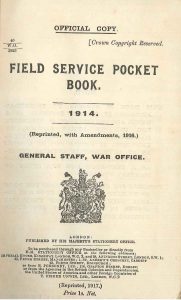 Field Service Pocket Book of the Royal Sussex Regiment
Field Service Pocket Book of the Royal Sussex RegimentFirst World War Field Service Pocket Book of Albert Prior [born c1900], Royal Sussex Regiment 1917
Voir la fiche complète -
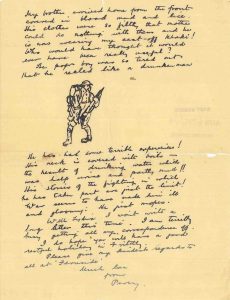 An illustrated letter from Percy Horton to [Lydia Sargent Smith] describing the physical and emotional state of Harry Horton on his return from war
An illustrated letter from Percy Horton to [Lydia Sargent Smith] describing the physical and emotional state of Harry Horton on his return from warHe describes how My brother arrived home from the front covered in mud and blood and lice. His clothes were so filthy that mother could do nothing with them and he is now wearing my cast-off khaki!...The poor boy was so tired out that he reeled like a drunken man…War seems to have made him ill and gloomy. He just mopes
Voir la fiche complète -
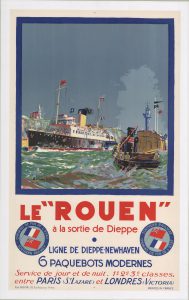 Poster Le Rouen
Poster Le RouenAdvertising poster issued by Chemins de fer de l'Etat et Southern Railway to promote the ferry service between Newhaven and Dieppe on Le Rouen. Printed around 1920.
Voir la fiche complète -
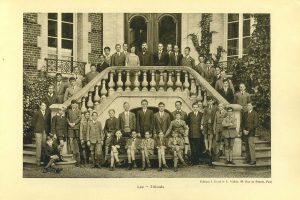 A public school in Mont-Cauvaire: photograph album
A public school in Mont-Cauvaire: photograph albumIn the Collège de Normandie, modelled on Harrow school in England, physical education and games were compulsory. Pupils played football, real tennis and lacrosse, and did gymnastics and fencing.
Voir la fiche complète -
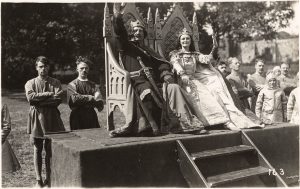 Re-enactment of the Battle of Hastings
Re-enactment of the Battle of HastingsPhotographs of the re-enactment of the Battle of Hastings at the Battle Abbey Pageant in July 1932. (ESRO: PCA 236/3, 5)
Voir la fiche complète -
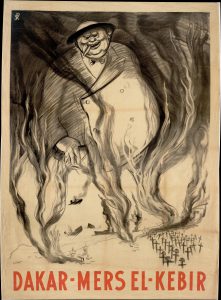 Second World War posters
Second World War postersOn November 11, 1939, King George VI responds to a telegram sent by Albert Lebrun in these terms : " We both have reason to be reassured that the joint efforts of the peoples of Britain and France will be successful and Europe will be safe from the brutal violence and that peace will be established on sound foundations of freedom and justice."
Voir la fiche complète -
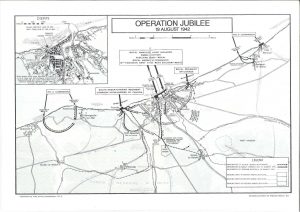 Account of the Dieppe raid (Operation Jubilee) by Roger Rothwell, clerk to Newhaven Town Council, published jointly by Newhaven Town Council and East Sussex County Council to mark the fiftieth anniversary of the event
Account of the Dieppe raid (Operation Jubilee) by Roger Rothwell, clerk to Newhaven Town Council, published jointly by Newhaven Town Council and East Sussex County Council to mark the fiftieth anniversary of the eventClerk to Newhaven Town Council, published jointly by Newhaven Town Council and East Sussex County Council to mark the fiftieth anniversary of the event.
Voir la fiche complète -
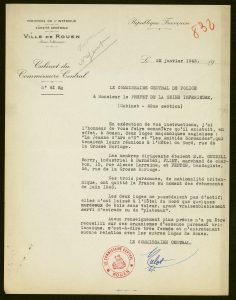 Report of the Commissioner of central Rouen on the work of two English Masonic lodges
Report of the Commissioner of central Rouen on the work of two English Masonic lodgesFreemasons being held responsible for the defeat, the Vichy government quickly takes action against them.
Voir la fiche complète -
 Hastings, for the perfect holiday in England, poster published by British Railways
Hastings, for the perfect holiday in England, poster published by British RailwaysPoster advertising Hastings to English and French visitors showing ferry routes between the south coast and France. Artist unknown.
Voir la fiche complète -
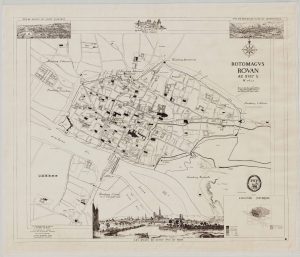 Maps of Rouen
Maps of RouenCartography of Rouen through ages Maps drawn after ancient documents by Edgard Naillon - Published by G. Lanfry, 1955
Voir la fiche complète -
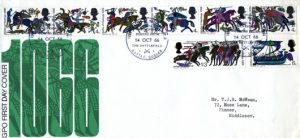 900th anniversary of the Battle of Hastings
900th anniversary of the Battle of HastingsFirst day cover issued by the Post Office on 14 October 1966 to commemorate the 900th anniversary of the Battle of Hastings.
Voir la fiche complète -
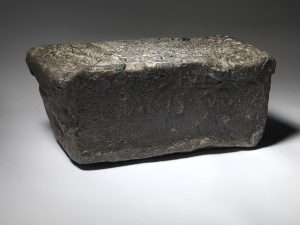 Lead ingot
Lead ingotAncient lead ingot found in Lillebonne in 1840, at the bottom of the Roman theatre's outer wall. Weight : 43,5 kg
Voir la fiche complète

